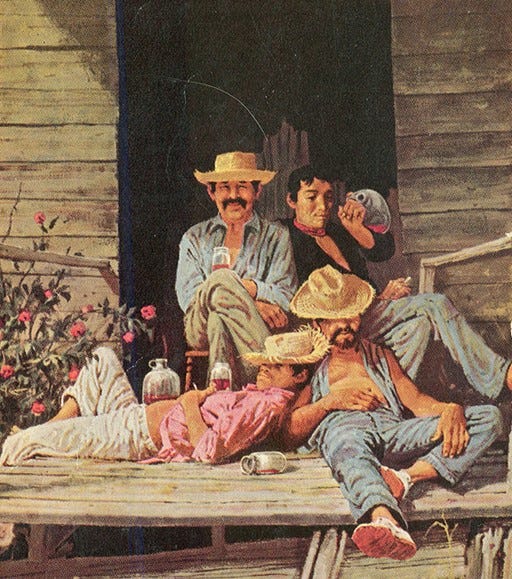Making America’s Mythology: ‘Cannery Row’ (John Steinbeck, 1945)
A review of Cannery Row, by John Steinbeck, 1945
Controversial to say, but I had a great COVID lockdown experience. I arrived back in the UK homeless, broke, and without a single item of clothing fit for the winter weather; just in time for the harshest of lockdown. I couldn’t go back to my parents so made a B-line for my best friend’s place in Bristol. I walked shivering across a desolate city, keeping my pace quick to fight the chill. Arriving around 5am in the morning and after ten minutes of insistent knocking my friend, John, finally opened up, bleary eyed and blinking.
“Ben…” he said, the first words we’d spoken in person in 2 years “…what the fuck are you doing here?”
So began some of the funnest months of my life. With nothing productive to do nor any real sense of the future (there was after all not an insignificant chance we’d all die of a plague) we lived completely in the moment. We hiked around deserted streets with bricks in our backpacks, wrote bad philosophies, climbed harrowing cliffs, broke into abandoned places, and built a bicycle out of scrap. They were petty thrills but felt like adventures. What made them so ripe and exiting was that they were endeavours done only for the excitement of experiencing them, with no thoughts given to the future, consequences, or good sense.
And this is exactly what Cannery Row captures. The plot, on the face of it, is about a few bums trying to throw a poorly conceived party for a biologist because they think he’s a swell guy; with the occasional and extremely reluctant aid of a Chinese greengrocer. The story is loose and unhurried, frequently detouring to discuss one of the other characters who live along 1930’s Cannery Row—the local whores, invalids, artists, stuntmen, prairie dogs and even an ancient one eyed Chinaman with the ability to impart glimpses of the celestial realm upon unsuspecting urchins.
Every scene is presented as its own self-contained vignette. This works thematically for Mack and his gang of fellow bums, as their plans are incredibly short sighted and largely made up on the fly through a combination of theft, whiles, and luck (or lack of it). But even Doc, the marine biologist who has to plan his life around tides and business orders, has his story presented as discrete moment’s unconcerned with future or past. This lack of timeliness and complete self-referential nature elevates these random snippets of life to adventurous, borderline mythical endeavours.
Mack and his gang’s frog-gathering trip turns into a Homeric triumph of wit and whiles. A neglected child’s attempt to help his benefactor becomes a Greek tragedy. Doc’s random but irrepressible desire for a beer milkshake has a Faustian drive for forbidden knowledge. Every little event in Cannery row has a sacred sheen to it. The novel culminates in a party of such legendary proportions that it is already being referred to in the past tense in the telling, as if such an event cannot truly have been lived, but merely recalled as a mortal tells tales of the affairs of gods.
And this is how Steinbeck captures so beautifully and poignantly why youth, parties, silly outings, and those wretched and irresponsible flatmates you once lived with leave such a tender impression on memory. They are complete moments in of themselves, and by their self-referentialness become timeless, and in becoming timeless they are unmoored from ‘normal life’ and into the mythical realm of recollection and nostalgia. Steinbeck was obsessed with Arthurian legend, and understood how to construct mythological narratives without resorting to archaic language or exclusivity focusing on the great and tragic. At its heart, Cannery Row is a mythologistion of Ed Ricketts, Steinbecks friend and the basis for the character Doc. The novel presents to its readers not just how to construct a mythology, but how to live your life so that it becomes one.
-Ben Shread-Hewitt
Other reviews of Steinbeck Novels:
The Platonic Picaresque: 'Tortilla Flat' (John Steinbeck, 1935)
Start writing today. Use the button below to create your Substack and connect your publication with Hwiccan Review.





